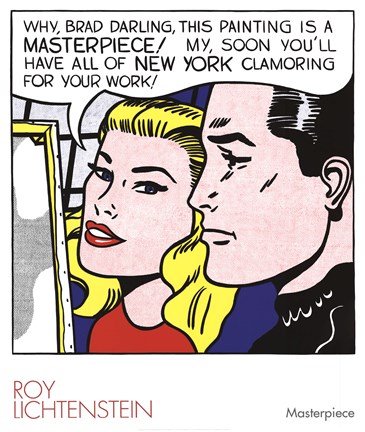
If you're searching for framed art that will add interest, color, and a touch of humor to a modern workspace or living room, take a look at the work of pop artist, Roy Lichtenstein. Known for replicating classic comic imagery on a large scale, his panels satirize 1960s American life while demonstrating a gift for bold composition. Lichtenstein rarely worked outside the color palette of comics - atomic yellows and reds fill vast planes of space, divided by magnified ink work. Lighter colors are rendered with dots to create an honest duplicate of Lichtenstein's source material.
The artist lampoons himself - or predicts his own eventual legendary status - in 1962's "Masterpiece." In the panel's dialogue box, a painter's girlfriend flings high hopes on her lover:
Why, Brad darling, this painting is a masterpiece! My, soon you'll have all of New York clamoring for your work!
The artist pictured looks somewhat doubtful, perhaps aware that his girlfriend is merely swooning.
In 1964's "Kiss V," Lichtenstein creates a gripping composition that divides the page diagonally, placing singular emphasis on the stream of tears flowing from the blond woman's simply rendered eye.
In "Washing Machine," the artist satirizes the image of femininity and motherhood with a line drawing of a hand pouring detergent into a load of laundry. Only the soap box and the clothes in the washer are filled with color, both of them yellow. By using color to specifically illuminate the action of washing, Lichtenstein could be implying that the woman to whom the manicured hand in the drawing belongs has been consumed by domesticity itself.
While Lichtenstein rarely disclosed his comic source material, a project by David Barsalou, "Deconstructing Roy Lichtenstein," has paired many of his paintings with their original source material. The side-by-side comparison demonstrates both the artist's devotion to replicating commercial comic production and his improvements upon the source. The artist tended to remove unnecessary elements, creating a bolder, simpler composition. Occasionally, shadows are added and colors are brightened for artistic effect and to heighten their intentionally mass-produced appearance.
For archival, museum-quality prints of works by Lichtenstein or other modern masters, peruse our extensive collection at FulcrumGallery.com. Framing options are available, and most orders ship the same day.

